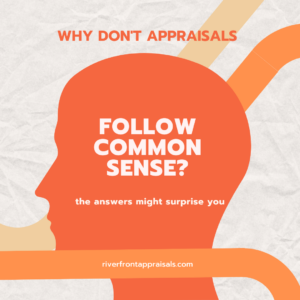
Property Taxes Just Went Up? We’ve Got You Covered!
It’s reassessment season for most folks in our area. Homeowners

If you’re new to our blog, let me first say ‘Welcome!’ If you’re a regular reader, then ‘Thank You!’ Either way, I’m happy you’re here, reading this post. This blog is part four of a 12-part series we’re calling The Loan Officer’s Guide to Appraisals. But don’t let the name fool you. Even though we’re focused mainly on helping lenders, everything we write can be helpful to you, even if you’re not in the lending profession! So far in our series, we’ve covered final inspections, lending on unique homes, and communication. In part four, we’re going to be looking at the reconsideration of value (ROV) process, tips for a successful ROV, and how to implement an ROV process if you don’t already have one.
Having a solid ROV process in place is extremely important, especially in today’s market. Appraisals are coming in below sale price now more than ever, with sale prices exceeding list prices by sometimes tens of thousands of dollars, and having a resource you can use to help make your case is a must-have for all Realtors and lenders. So read on!
Before we get into all the juicy details, let me throw out one caveat: A reconsideration of value won’t always work. This blog isn’t intended to promote a ‘just do this and you’ll never lose another deal’ mindset. If I had to guess, I’d say that the majority of ROVs don’t work. But I’d also say that’s because they’re done in the wrong way. If you follow the steps below, and present your case the right way, I guarantee you’ll have better success with your request.
And one last thing before we get to the good stuff! I know that some lending institutions do not have a process for challenging an appraisal. Some simply refuse to entertain another opinion, while other lenders just don’t have a process in place. So if you’re the latter, you’re in the right place! And if you’re the former, perhaps after reading this blog, you’ll see just how easy and helpful a process for reconsideration requests can be.
So here are my words of advice to lenders, although as with much of what I write, this information can be helpful to anyone in the home selling or refinancing process.
First, it’s important to know what role you play in the process. Remember that the appraiser is a highly qualified professional who does this thing called appraising for a living. And most likely you are not. Just remember that when communicating with the appraiser. Approach the topic carefully, respectfully, and humbly. This goes A LONG way with an appraiser. I’m going to be really honest here, and say that the vast majority of communication we have with lenders (dealing with reconsiderations) is respectful. However, homeowners and Realtors are not always so forgiving. So if that’s you – keep reading!
Speaking of reading, whoever has a copy of the appraisal needs to make sure the appraiser hasn’t materially misrepresented the home being appraised. Is the square footage what you thought it should be? Are the bedrooms & bathrooms accurate? Did the appraiser list all of the improvements made in the last 10-15 years? This is a good starting place to point out errors, as some may actually impact value. So don’t just glance through our 35 page report, and then look at one line on one page (the value). Take your time!
Recently, a friend of mine had his home appraised. The appraiser missed all of the updates they had recently completed, which affected their appraised value. It happens. It shouldn’t happen much, but it does happen. And it’s because appraisers are human, and we make mistakes. The good thing is, mistakes can be fixed!
Usually minor mistakes or omissions won’t affect the value greatly (if at all). So where you want to focus your attention is comps. Look through the comparable sales the appraiser used. They should all be located in or near the subject’s neighborhood, so you (or the borrower) might have some insight into these homes that the appraiser didn’t have. Did Comp #2 sell in foreclosure and the appraiser missed it? That could be a huge oversight. Was Comp #1 inferior in overall condition but the appraiser called it similar? These are things that would be helpful for an appraiser to know.
Once you’ve seen which sales the appraiser used – and didn’t use – it’s now up to you to provide alternate sales. Maybe the appraiser missed a sale, or didn’t know a home just down the street closed a few days earlier. Either way, providing these sales could really help your case. If done right. What’s the mindset behind providing alternate sales? Well to be frank, most appraisers think of it this way: if you’re going to accuse me of being wrong, then you need to approach it in the same way I did. Just like I used comparable sales to develop my opinion, you need to do the same. So don’t pick a fight, don’t argue, and don’t just make baseless claims, because that’s not what appraisers do. Meet us at our level. Do the work. I guarantee you things will go better for you.
Here are some additional things to keep in mind when providing alternate sales. The sales you provide to the appraiser need to be as comparable or more comparable than the sales already in the report. What’s this mean? Imagine the home being appraised is a 1,300 square foot home. The sales used in the appraisal ranged from 1,200 – 1,400 square feet. If the alternate sales you provide are all over 1,600 square feet, then it’s likely that the appraiser won’t even consider them. The appraiser needs to have a compelling reason to include alternate sales provided by the homeowner, Client, or Realtor. Don’t go out and just find the highest priced sale you could find (which is what happens most of the time). Also, if the sales the appraiser used all sold in the last three months, and you provide a 14-month old sale, then the appraiser will probably not use that sale (unless there’s a really good reason).
Also, when you provide alternate sales, make sure & include commentary that explains why your sales are more comparable to the subject property than the sales used by the appraiser.
One key factor every party needs to remember is that no one can try to pressure the appraiser. Even in reconsideration requests, your attempt to ‘make the numbers work’ cannot be seen as pressuring the appraiser. So try to communicate your findings and sales in a way that doesn’t say, “These sales support our contract price of $200,000.” An appraiser cannot be pressured to ‘hit’ a specific number. Remember, it’s called a Reconsideration of Value Request. You’re not asking the appraiser to change the report, but to reconsider the value. This is key.
Finally, make sure the information you provide to the appraiser is short & sweet (literally!). The appraiser doesn’t have time to read a 20-page document on why this home is worth $200,000. Make a list of the items the appraiser missed, point out why the comps used were not the best, and describe the new sales you’re providing in a concise, yet helpful way. And be nice. I can’t stress this enough. Appraisers live in a world where everyone thinks they can do our job. If you approach this topic correctly, the appraiser will be much more likely to at least look at what you have to say. Plus, it’s just part of being a decent human being. Everyone enjoys it when people are nice to them. Don’t you?
So once you’ve got your case together, now what do you do with it? As we’ve mentioned before, an appraiser cannot be pressured to hit value. One way the Powers That Be try to keep this from happening, is that no one can discuss value with an appraiser except for the client (unless the client gives the green light). So if you’re a homeowner or Realtor, once you have your reconsideration request filled out (see below for an example), get it to the bank that ordered the appraisal, and they’ll pass it along to the appraiser. This keeps everything on the up & up and no one can be seen as influencing or being influenced. Unless the appraisal was prepared for you personally (i.e. private, non-lending appraisal), do not send the request directly to the appraiser. And, if you’re a loan officer, just collect that information (or prepare it yourself), and get it to the appraiser. Do not encourage your borrower or the Realtor to contact the appraiser directly.
Finally, if you’re one of the loan officers we mentioned at the beginning of this blog that does not have a process in place for reconsiderations, have we got a treat for you! To serve our community, we created a free template, called Reconsideration of Value Request, and we’d love for you to check it out here. Once it’s filled out, simply send it on to the appraiser.
Link to resource: https://riverfrontappraisals.com/how-to-challenge-your-real-estate-appraisal/reconsideration-of-value-request/
If you have any other specific questions about how you can challenge an appraisal, send us an email to info@riverfrontappraisals.com.
Committed to helping you understand your home’s market value,
Ryan Bays, SRA, AI-RRS

It’s reassessment season for most folks in our area. Homeowners

I feel like we all need a laugh. How about

So this may be a slight break from the norm,
Riverfront Appraisals has been providing comprehensive valuations of residential properties to Western Kentucky and Southwestern Indiana since 2008.